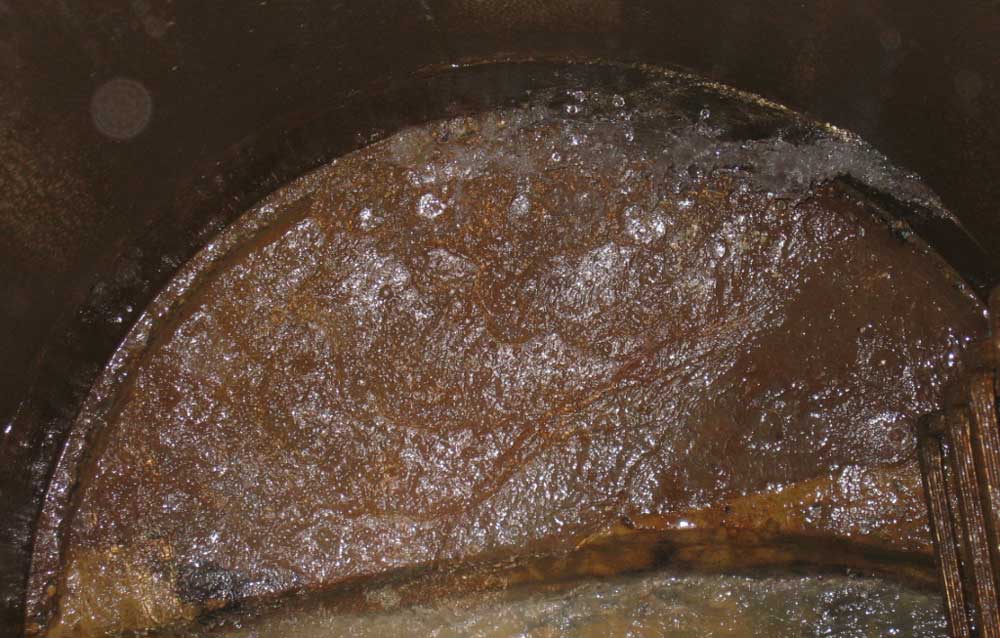
Severe Infiltration Stopped Using Mechanical Internal Joint Seal
A small southeastern Pennsylvania Municipal Authority identified a manhole with a severe infiltration problem that needed immediate repair. This Authority has 4,800 sewer connections and maintains and operates 18 pumping stations, which pumps sanitary sewerage to a neighboring wastewater treatment plant.
The Authority has an agreement with the nearby Borough WWTP to send its untreated effluent for processing. The agreement between the parties guarantees that only 42 percent of the plant capacity can be used, so any excess flow caused by inflow or infiltration could prove costly. The water was coming from an extremely high ground water table and was leaking through the barrel joint near the bottom or deepest part of the manhole. It is unknown how long this manhole had been leaking, but this single manhole was contributing an estimated 72,000 gallons of clear water every single day.
The Authority staff began searching the internet for a solution to solve the problem and after looking at options such as hydraulic cement and chemical grout, it decided to try the Internal Manhole Joint Seal from Cretex Specialty Products. The Cretex Internal Manhole Joint Seal is a mechanical seal that is made up of a high-quality rubber seal and stainless-steel expansion bands. These bands compress the rubber seal against the manhole wall above and below the joint creating a watertight seal. The Authority read that these seals had been in use since the late 1980s so the technology appeared to be well proven and the solution they were looking for. The information also stated that the seals can typically be installed by one worker, which helps minimize risk because only one person would have to enter the manhole to perform the installation.
RELATED: Manhole Rehab – How’s It Looking in 2020?

Cretex Specialty Products was contacted, and the Authority found out that a factory representative was available to be onsite for installation training and to assist the staff, if necessary. Based on the material cost, product information and factory support, their minds were made up to use this seal on their leaking manhole.
After the order was placed for the seal and installation tool, a Cretex Specialty Products Regional Sales Manager made arrangements to be onsite with the crew from the Authority on the scheduled day of the installation to conduct training and any guidance during the actual seal installation.
On the jobsite, a brief overview of the surface preparation, installation steps and technique were conducted with the crew above ground near the manhole. This overview involved assembling the seal and bands and demonstrating the use of the retaining band expansion tool and how to secure the bands with the stainless-steel fasteners once compressed against the manhole wall and tight.

Since this seal required man entry for the installation, the Authority staff had already taken care of the necessary confined space paperwork and notifications. They set up the tripod and had been ventilating the manhole with a blower prior to the above ground training and were ready to install the seal.
RELATED: A PRO Approach to Manhole Rehabilitation
One of the Authority staff connected their harness to the tripod and entered the manhole to assess the surface of the manhole wall to determine the need for any surface preparation or repair. Since this was the bottom joint, the worker was able to stand and kneel on the manhole bench for the work. The manhole was precast and the wall above and below the joint was in good condition, only requiring a light scraping using a putty knife. The seal, expansion bands and installation tool were all lowered into the manhole. The rubber seal was positioned so one band recess was above the joint and the other below the joint.

Since there was a significant volume of water coming in through the joint, the band above the joint was installed first. The first two-piece expansion band was assembled using the stainless-steel studs and nuts, lubricated with the supplied band lubricant and positioned into the band recess. The band expansion tool was inserted into the band and using a 15/16-in. socket and ½-in. drive ratchet, the band was slowly expanded until it was tight and then the fasteners were tightened. Now the leaking water was cascading down the wall of the manhole and the second (lower) band could be assembled, lubricated, and positioned in the band recess as before. Following the previous steps, the band expansion tool was inserted into the band and tightened, only this time, as the band compressed against the manhole wall, the leak began to slow down until no more water was leaking into the manhole, like turning off the faucet.
The complete surface preparation and installation of the Cretex Internal Manhole Joint Seal was completed in just over an hour by one worker, despite he had never installed this product before. The Authority were very impressed with the ease of installation and final result that this seal provided. It was also noted that stopping this one leak will likely save tens if not hundreds of thousands of dollars in treatment and transportation costs during the expected 50-year design life of the seal.
Lee Haessig is regional sales manager at Cretex Specialty Products.



